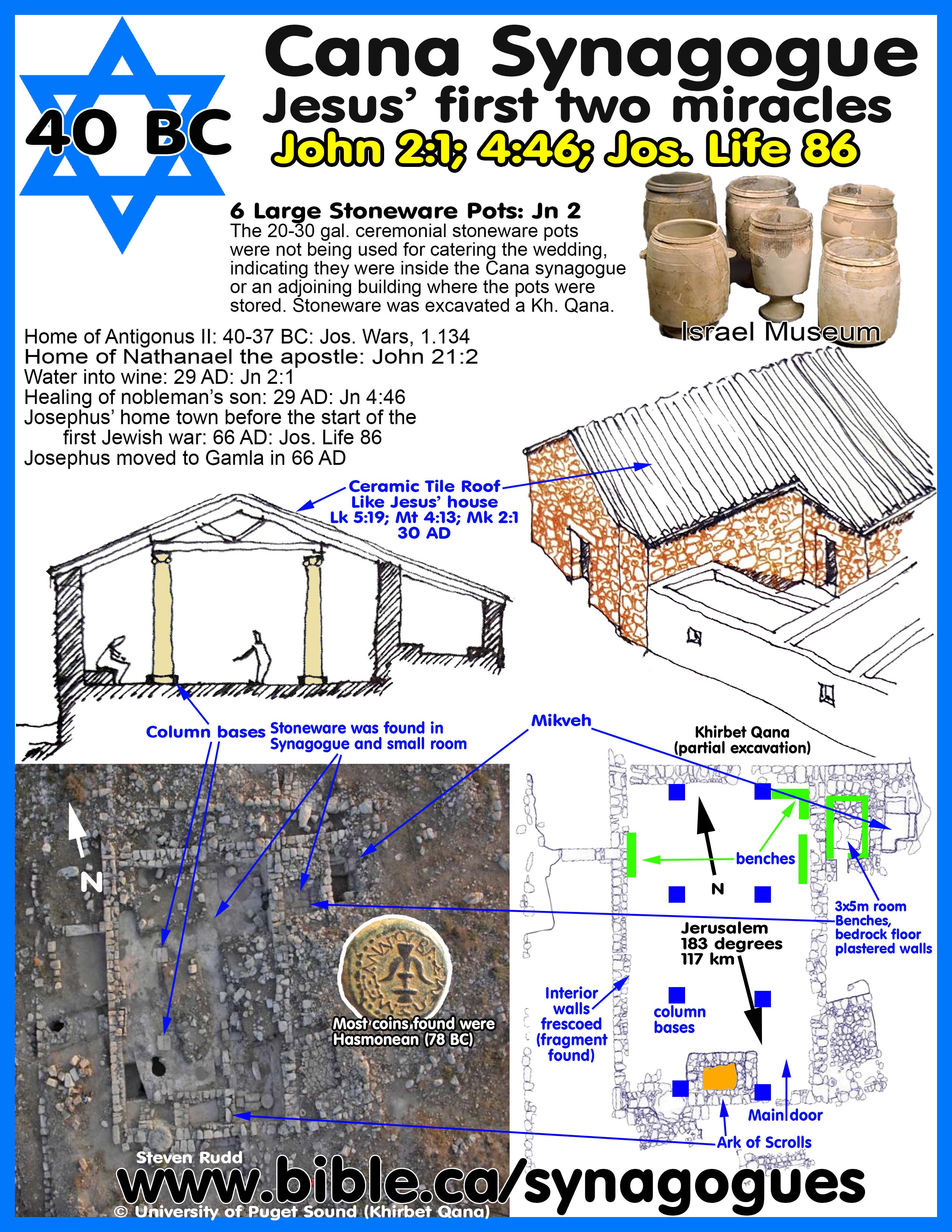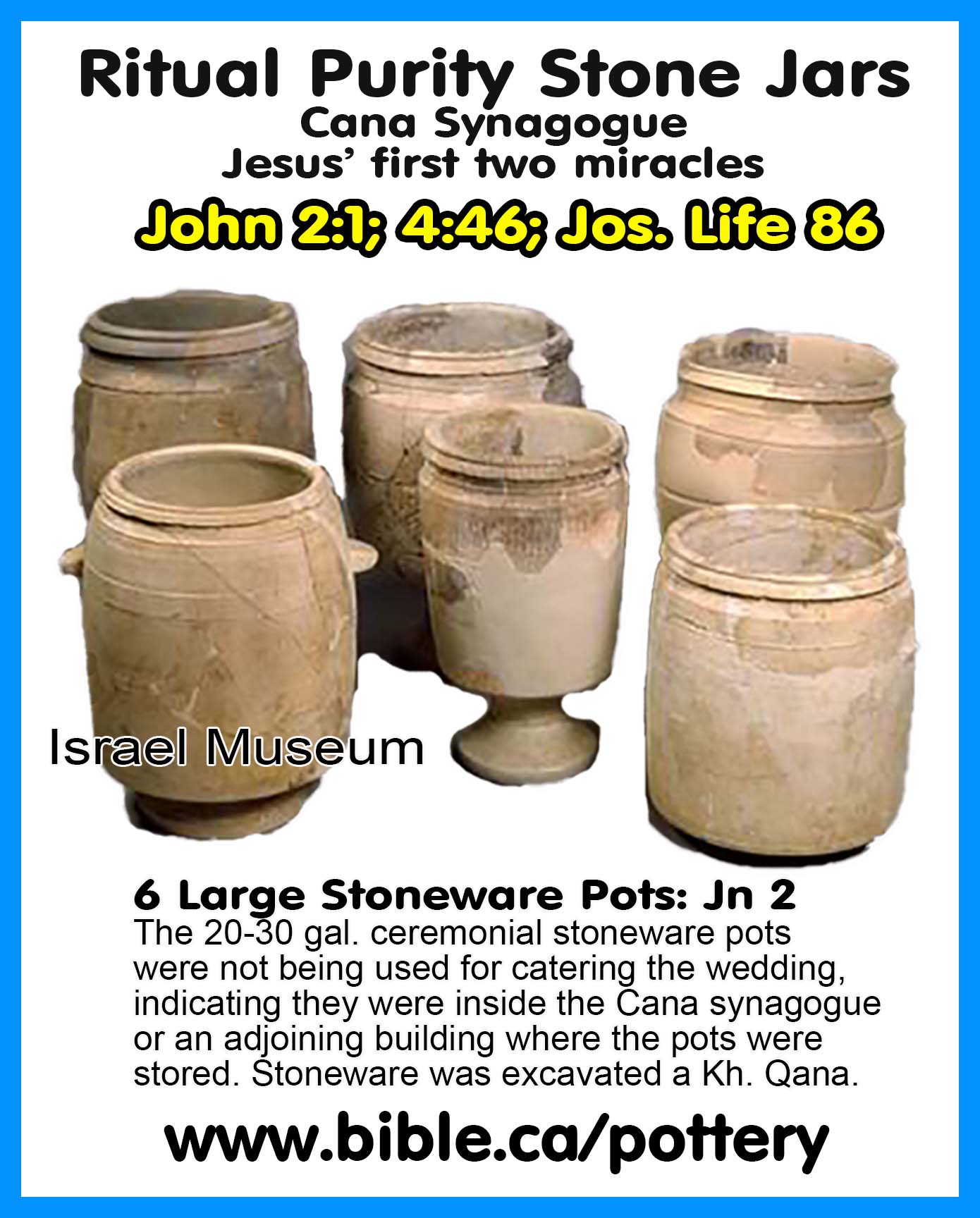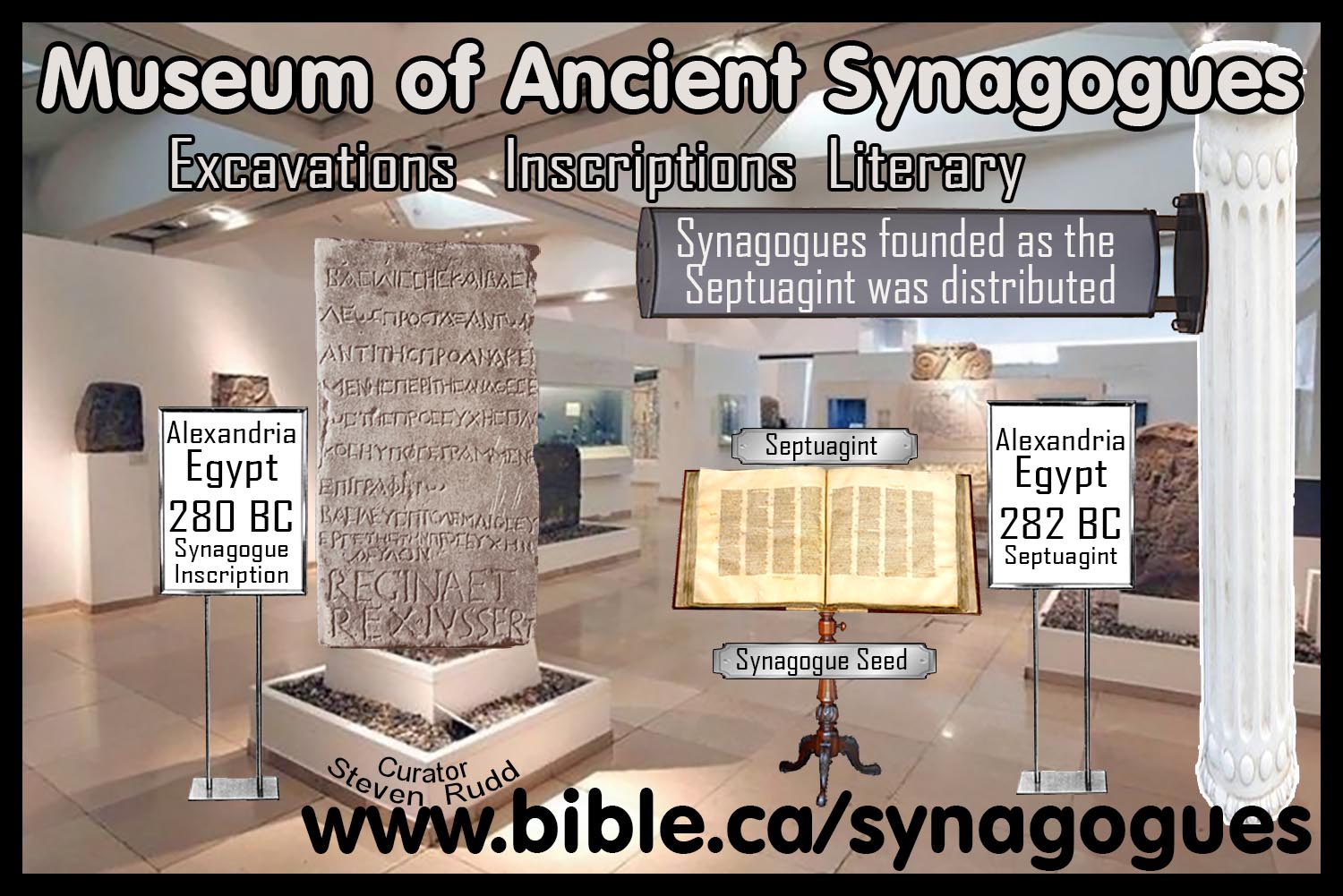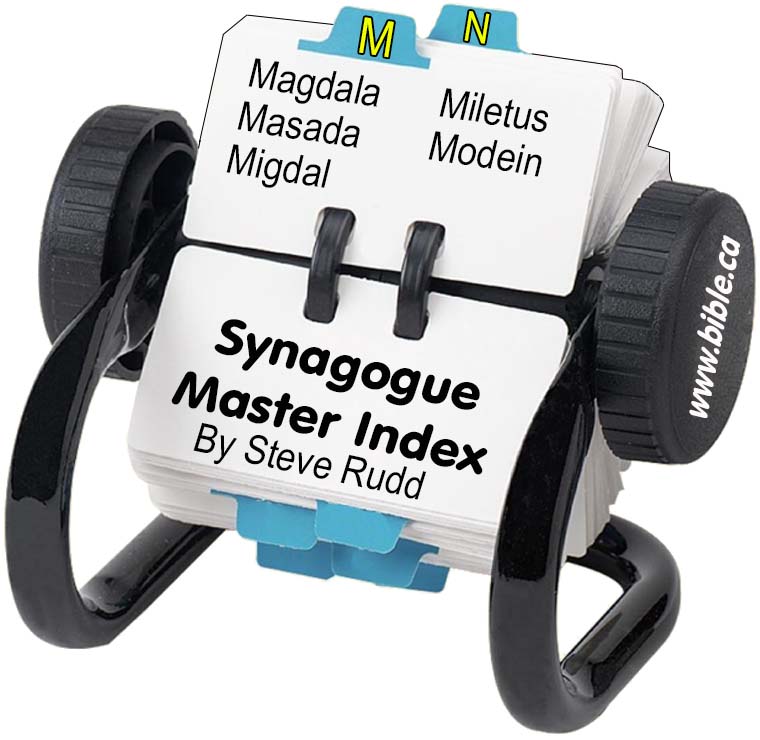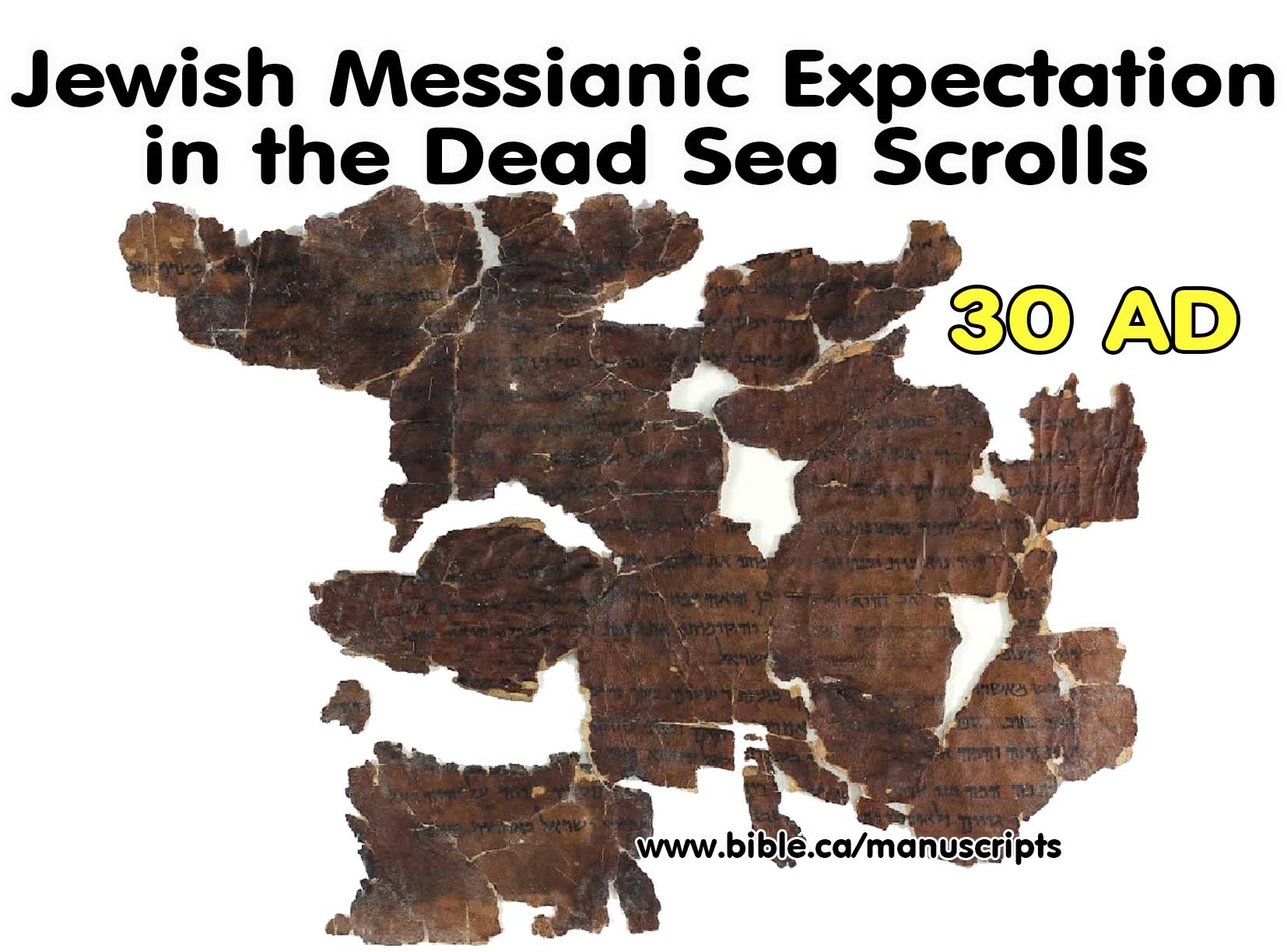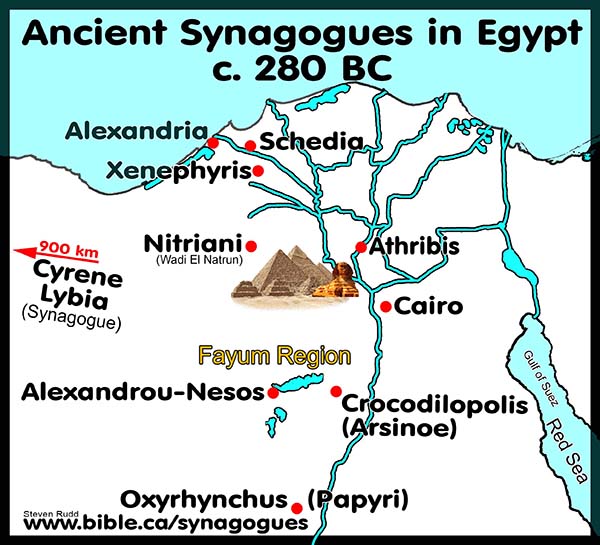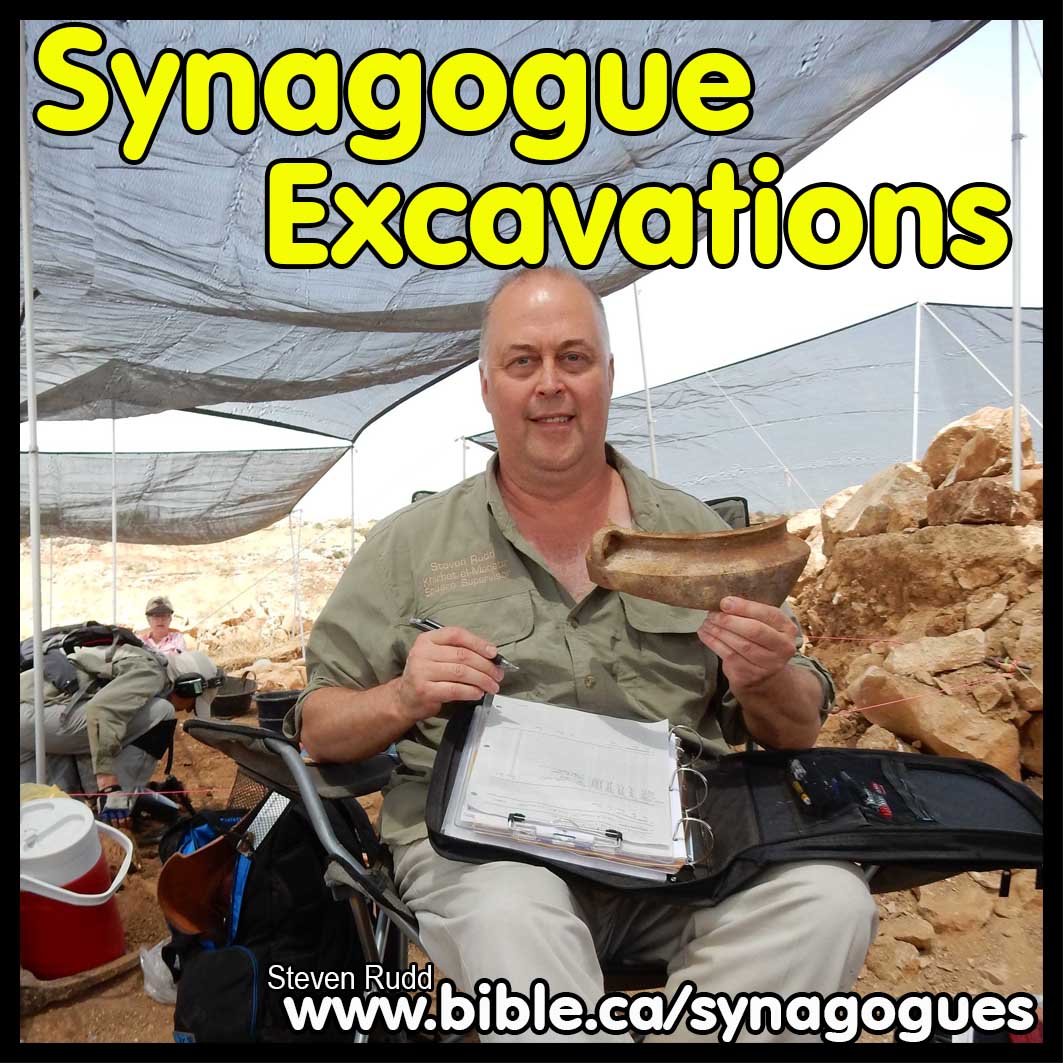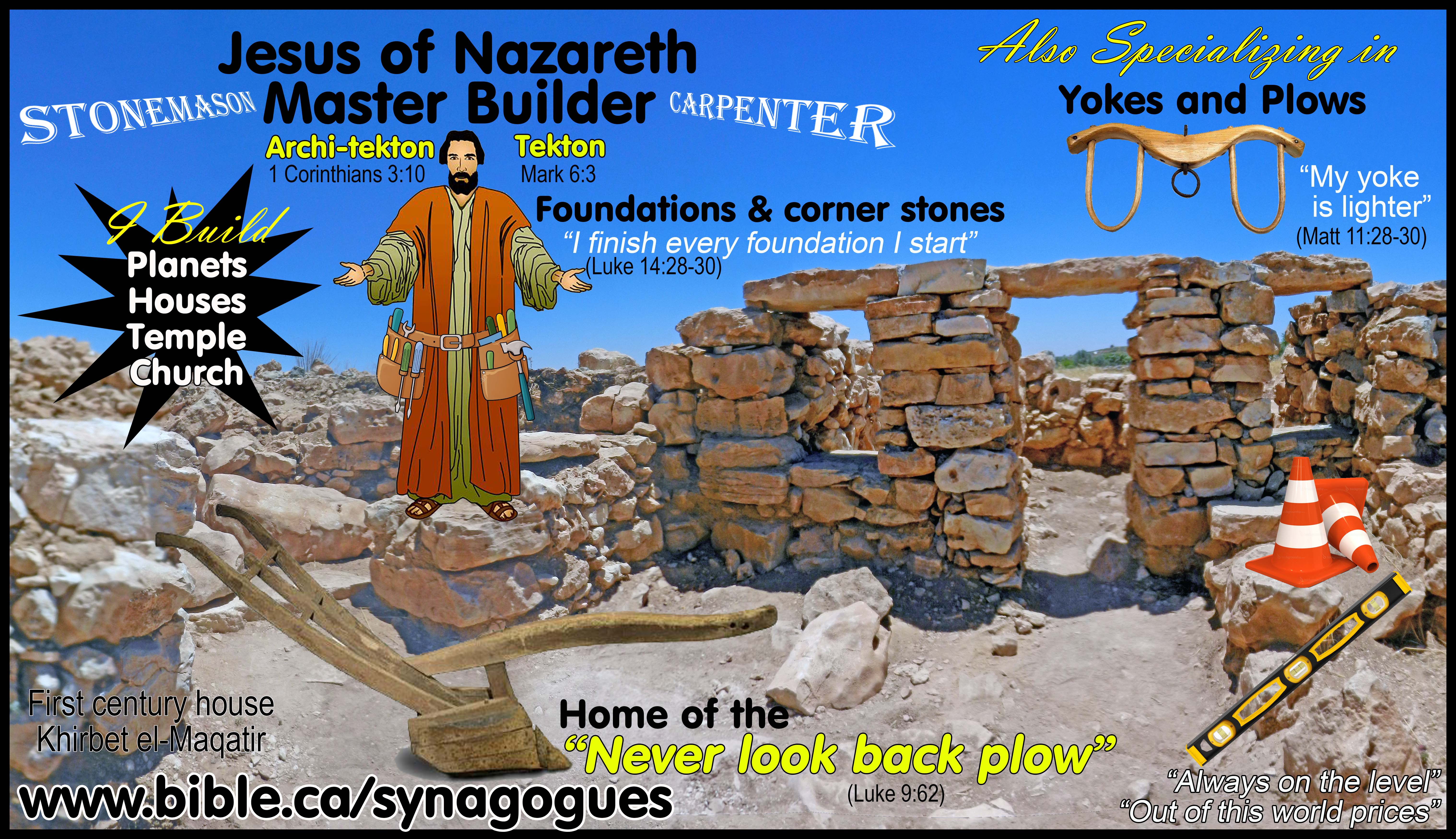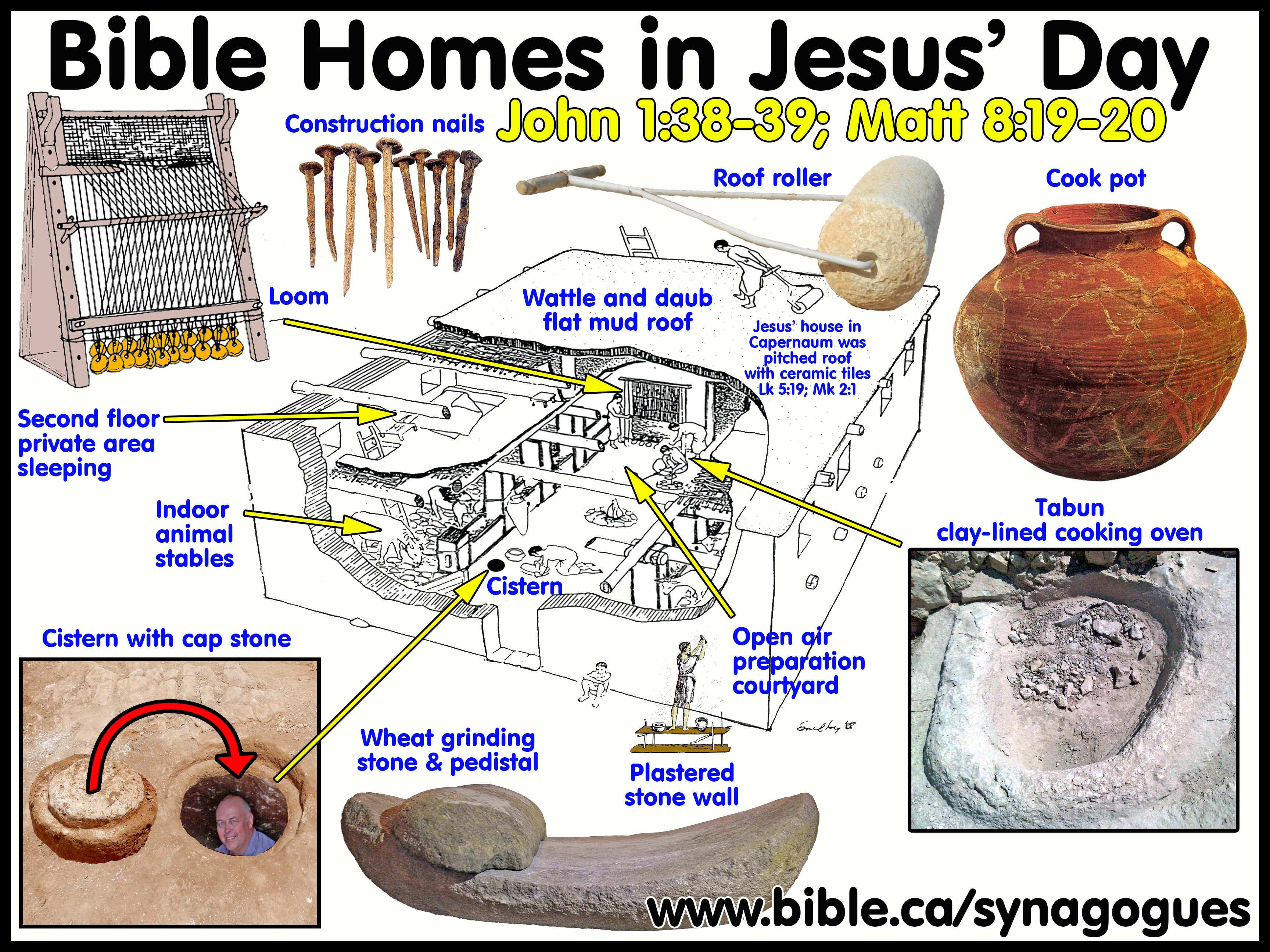First Century Synagogue Top Plans: Cana 40 BC
Archeological Excavations of Oldest Synagogues in the world
|
Cana 40 BC |
Introduction:
First Century Ritual purity stone Vessels: Stoneware cups and wash basins
1. 6 Large Stoneware Pots: Jn 2
2. The 20-30 gal. ceremonial stoneware pots were not being used for catering the wedding, indicating they were inside the Cana synagogue or an adjoining building where the pots were stored. Stoneware was excavated a Kh. Qana proving it was a first century synagogue at the time of Jesus.
3. Stoneware outline
A. Earliest Synagogue Occupation Date (SOD) = 40 BC
1. Excavation date: first century
2. Inscriptional date: none
3. Literary date:
4. SOD computation system details: Excavation date + Inscriptional date + Literary date = SOD.
5. Discussion:
a. Dated by plaster to first century by coins, plaster and stoneware. The 6 stoneware pots at the wedding feast in John 2 confirm this.
B. Synagogue Compass Orientation:
1. Orientation East or towards Jerusalem: no
2. Compass headings:
a. Compass heading towards Jerusalem: 183 Degrees
b. Distance to Jerusalem: 117 Kilometers
3. When an archeologist begins excavating a newly discovered synagogue, the first thing he does to determine if it is a first temple, pre-70 AD installation is determine the orientation.
a. If the synagogue points east it is not pre-70 AD but built after 200 AD.
b. If the synagogue is oriented towards Jerusalem it is not pre-70 AD but built after 200 AD.
4. See Orientation: Early Synagogues did not Point to Jerusalem
C. Bible and other Literary references:
1. "On the third day there was a wedding in Cana of Galilee, and the mother of Jesus was there; and both Jesus and His disciples were invited to the wedding. When the wine ran out, the mother of Jesus said to Him, “They have no wine.” And Jesus said to her, “Woman, what does that have to do with us? My hour has not yet come.” His mother said to the servants, “Whatever He says to you, do it.” Now there were six stone waterpots set there for the Jewish custom of purification, containing twenty or thirty gallons each. Jesus said to them, “Fill the waterpots with water.” So they filled them up to the brim. And He said to them, “Draw some out now and take it to the headwaiter.” So they took it to him. When the headwaiter tasted the water which had become wine, and did not know where it came from (but the servants who had drawn the water knew), the headwaiter called the bridegroom, and said to him, “Every man serves the good wine first, and when the people have drunk freely, then he serves the poorer wine; but you have kept the good wine until now.” This beginning of His signs Jesus did in Cana of Galilee, and manifested His glory, and His disciples believed in Him. After this He went down to Capernaum, He and His mother and His brothers and His disciples; and they stayed there a few days." (John 2:1–12)
2. "Therefore He came again to Cana of Galilee where He had made the water wine. And there was a royal official whose son was sick at Capernaum. When he heard that Jesus had come out of Judea into Galilee, he went to Him and was imploring Him to come down and heal his son; for he was at the point of death. So Jesus said to him, “Unless you people see signs and wonders, you simply will not believe.” The royal official said to Him, “Sir, come down before my child dies.” Jesus said to him, “Go; your son lives.” The man believed the word that Jesus spoke to him and started off. As he was now going down, his slaves met him, saying that his son was living. So he inquired of them the hour when he began to get better. Then they said to him, “Yesterday at the seventh hour the fever left him.” So the father knew that it was at that hour in which Jesus said to him, “Your son lives”; and he himself believed and his whole household. This is again a second sign that Jesus performed when He had come out of Judea into Galilee." (John 4:46–54)
3. "Simon Peter, and Thomas called Didymus, and Nathanael of Cana in Galilee, and the sons of Zebedee, and two others of His disciples were together." (John 21:2)
D. Occupation history:
1. Pottery dating to the Iron age: Deborah to Solomon.
2. Tiglath Pileser, king of Assyria, mentioned the city of Kanna in the annals of his military campaign through Israel.
3. Hometown of Antigonus II, 40-37 BC
a. “Now as Antigonus [II, 40-37 BC]had a mind to appear to exceed Herod not only in the courage but in the number of his men, he sent Pappus, one of his companions, with an army against Samaria, (334) whose fortune it was to oppose Macheras. But Herod overran the enemies’ country, and demolished five little cities, and destroyed two thousand men that were in them; and burned their houses, and then returned to his camp; but his headquarters were at the village called Cana.” (Josephus, Wars 1.333-334, 40-37 BC)
4. Home town of Nathanael:
a. "Simon Peter, and Thomas called Didymus, and Nathanael of Cana in Galilee, and the sons of Zebedee, and two others of His disciples were together." (John 21:2)
b. "Philip found Nathanael and said to him, “We have found Him of whom Moses in the Law and also the Prophets wrote—Jesus of Nazareth, the son of Joseph.” Nathanael said to him, “Can any good thing come out of Nazareth?” Philip said to him, “Come and see.” Jesus saw Nathanael coming to Him, and said of him, “Behold, an Israelite indeed, in whom there is no deceit!” Nathanael said to Him, “How do You know me?” Jesus answered and said to him, “Before Philip called you, when you were under the fig tree, I saw you.” Nathanael answered Him, “Rabbi, You are the Son of God; You are the King of Israel.” Jesus answered and said to him, “Because I said to you that I saw you under the fig tree, do you believe? You will see greater things than these.” And He said to him, “Truly, truly, I say to you, you will see the heavens opened and the angels of God ascending and descending on the Son of Man.”" (John 1:45–51)
4. Hometown of Josephus:
a. “Accordingly, I [Josephus] did not hinder him, as having no suspicion of any wicked designs of his; and I wrote to those to whom I had committed the administration of the affairs of Tiberias by name, that they should provide a lodging for John, and for such as should come with him, and should procure him what necessaries soever he should stand in need of. Now at this time my [Josephus] abode was in a village of Galilee, which is named Cana.” (Josephus, Life 86)
5. “History of Cana of Galilee: Cana of Galilee has a long history. Worked stone littering the site indicates occupation as far back as the Neolithic period. Iron Age (1200-586 B.C.E.) pottery is also evident. The Assyrian King Tiglath Pileser mentioned a city of Kanna in annals detailing his military campaign across northern Israel. And the town probably had important links to the Greek-speaking Seleucid empire, which controlled much of the area to the north and east (present-day Syria, Lebanon, and Iraq) after the death of Alexander the Great in the fourth century B.C.E. By mid-second century B.C.E., a major power shift had occurred in the region when a revolt led by Judas Maccabeus and his brothers (called the Maccabean revolt) established Jewish rule in Jerusalem. As their rule extended to the north to include Galilee, much of Cana probably became Jewish. When the Romans took over the region in 63 B.C.E., major changes began to alter the landscape. The city of Sepphoris was built (and rebuilt) on the other side of the Bet Netofah Valley from Cana, and bustling trade began taking place between Cana and such nearby pottery villages as Shikhin and Kefar Hananya in upper Galilee. With the Roman conquest, people of the town also witnessed increasing turmoil. A Galilean Jewish peasant named Jesus, who lived in nearby Nazareth, stirred up the population so much that the Romans crucified him as a criminal. The New Testament tradition has Cana housing a king’s man (John 4:46-54) and places Jesus there during a wedding feast (John 2:1-11). A major Jewish revolt took place against the Romans beginning in C.E. 66. Josephus, a Jewish historian, mentions Cana as a small town he visited during the first century Jewish Wars (Vita 16.41). People in Cana in July 67 would have seen a large Roman army march along the Wadi (valley) Yodefat at the western base of their hill to fight and win their first major battle against the Jews at Yodefat (Jotapata), only 3 kilometers away. After the revolt, Cana grew, possibly from refugees fleeing battles around Jerusalem. But changes in the larger world were again to transform the town. Constantine gradually converted the Roman Empire to Christianity, and by the fifth of sixth century some unknown Christian group came to Cana and built what appears to be a large monastery directly over the earlier Jewish town. Numerous coins and very high-quality imported ceramic wares indicate that this group was quite well-to-do (perhaps due to profits from an increasing pilgrim trade of subsidies from the Christian emperor). Arabs then brought Islam to the region and Christianity began to fade. It was re-established when Crusaders took control of the region for about two centuries starting around C.E. 1000. On July 4, 1187, the balance of power changed again. People from Cana, with their great view of the valley, no doubt saw a large Crusader army marching to battle at the horns of Hattin (near the Sea of Galilee) against Islamic forces led by the great military general Saladin. The battle resulted in a resounding defeat of the Crusaders from which they never fully recovered. Cana passes out of history shortly thereafter and appears to become a small agricultural village until its abandonment and demise around 1837.” (Sifting Through the Past: the Geospatial Future of Archaeology, Douglas R. Edwards, Geo Info Systems 10, p26, 2000 AD)
E. Excavation details:
1. Excavation report: “Excavation of an elite house on the hilltop has been crucial to understanding the occupation sequence (Plates 19, 20). The house was used over a long period, and while it is not yet clear when it was first built, much of the structure was early Roman. Several stages are visible in walls and floors, especially in the main courtyard, which had a large rock-cut cistern and rectangular pit. The courtyard was entered from a street or lane; opening off the courtyard was a monumental room with plastered walls and floors, which at a later stage had a beautifully carved capital on a pilaster. The pilaster must have supported an arch spanning the width of the room and supporting a second floor. Trapezoidal walls (about 45x75 m) initially were interpreted as a monastic complex covering the whole hilltop, including the elite house. In fact, the hilltop walls were defensive walls from the Persian invasion or Muslim conquest (614 or 634 C.E.). Another part of the wall in the southwest, however, was early Roman, finer and more monumental than the rest; it is from a public building of some sort, perhaps a synagogue (see Plates 15-18). Attached to it is a smaller room that may be a Beth ha-Midrash. The main room is 10x15 m, with intermittent benches, column bases laid out precisely on a 5x5 m nave, with 2.5x5 m side aisles. The adjacent room is about 3x5 m, with continuous benches on three (perhaps four) sides. A monumental capital fits this interpretation, though there is still no clear proof of the building's identification as a Jewish public building. The building is unusual architecturally, though some features have parallels with public buildings at Chorazin, Gamla, and Khirbet Shema`, all of which have a room that functions as a study house. In the squares associated with these two rooms, roof tiles—some embedded in constructions from obviously later periods [Rudd comment: Richardson says this because many archeologists wrongly believe that ceramic roofing tiles were not used in the first century AD, in spite of the fact that Jesus’ own house had roofing tiles: John 2:1; 4:46; Jos. Life 86, I have excavated roof tiles and stoneware from the first century city at Kh. Maqatir, Ephraim] —and one small piece of fresco reinforce the picture of a monumental building. The fresco has pink, red, gray, and yellow-ochre paint in a geometric pattern, not unlike the colors of the large first-century house at Yodefat, Hasmonean coins (a majority of the coins found on the site) and pieces of stoneware (a majority of which were found in the vicinity of the monumental building) strengthen the evidence for a first-century Jewish community at Khirbet Qana. (Building Jewish in the Roman East, Peter Richardson, p104, 2004 AD)
2. “Khirbet Qana has recently been identified as the site of Cana of the New Testament (see above, No. 2). Excavations under the direction of Douglas R. Edwards, University of Puget Sound, are not yet completed, but significant reports and articles have been published. The main hall of the building measures 10 x 15 m. The edifice had columns, each of which sat on three dressed foundation stones. Floors in the aisles were plastered, but the nave's floor is dressed bedrock. Furthermore, the main hall contained a discontinuous bench of various widths, lining three of the walls. To the east, there was a smaller room, measuring 3 x 4 m; this room also had a single low bench on three sides, with a bedrock floor. While this may have been a study room (so Richardson, Building Jewish, 66), the term bet ha-midrash should be avoided, since it may lead to the faulty impression that the rabbis were heavily involved in the early synagogue. The building is dated to the late first or early second century C.E. (Rech et al. 2003). While it is too early to draw any firm conclusions regarding the edifice, it is clear that we are dealing with a public building, and it seems likely that Edward's and Richardson's assessment is correct, i.e., that this building should be identified as a synagogue. The question of identification is, of course, dependent on the definition of "synagogue." From the perspective of Runesson's distinction between public and semi-public institutions, the evidence as described in the reports and articles so far seems to indicate a public institution housed in a public building.” (The Ancient Synagogue from its Origins to 200 AD, Anders Runesson, p23, 2008 AD)
3. Other Literature: Edwards, "Khirbet Qana"; idem "Recent Work in Galilee"; Rech et al., "Direct dating of plaster and mortar"; Richardson, Building Jewish, 55-71; 91-107; idem, "Khirbet Qana," 136-140, 144.
Conclusion:
1. Based upon the excavation report of Hasmonean coins, the pottery, the roofing tiles, the plaster and the stoneware, and the two literary references, it is clear that there was a synagogue with an SOD occupation date of 40 BC and probably much earlier.
2. See also: First Century Jewish Messianic Expectation: As witnessed in the Dead Sea scrolls.
By Steve Rudd 2017: Contact the author for comments, input or corrections
|
Jesus your messiah is waiting for you to come home! |
|
|
Why not worship with a first century New Testament church near you, that has the same look and feel as the Jewish Synagogue in your own home town. As a Jew, you will find the transition as easy today as it was for the tens of thousands of your forefathers living in Jerusalem 2000 years ago when they believed in Jesus the Nazarene (the branch) as their messiah. It’s time to come home! |
|
By Steve Rudd: Contact the author for comments, input or corrections.
Go to: Main Ancient Synagogue Start Page
